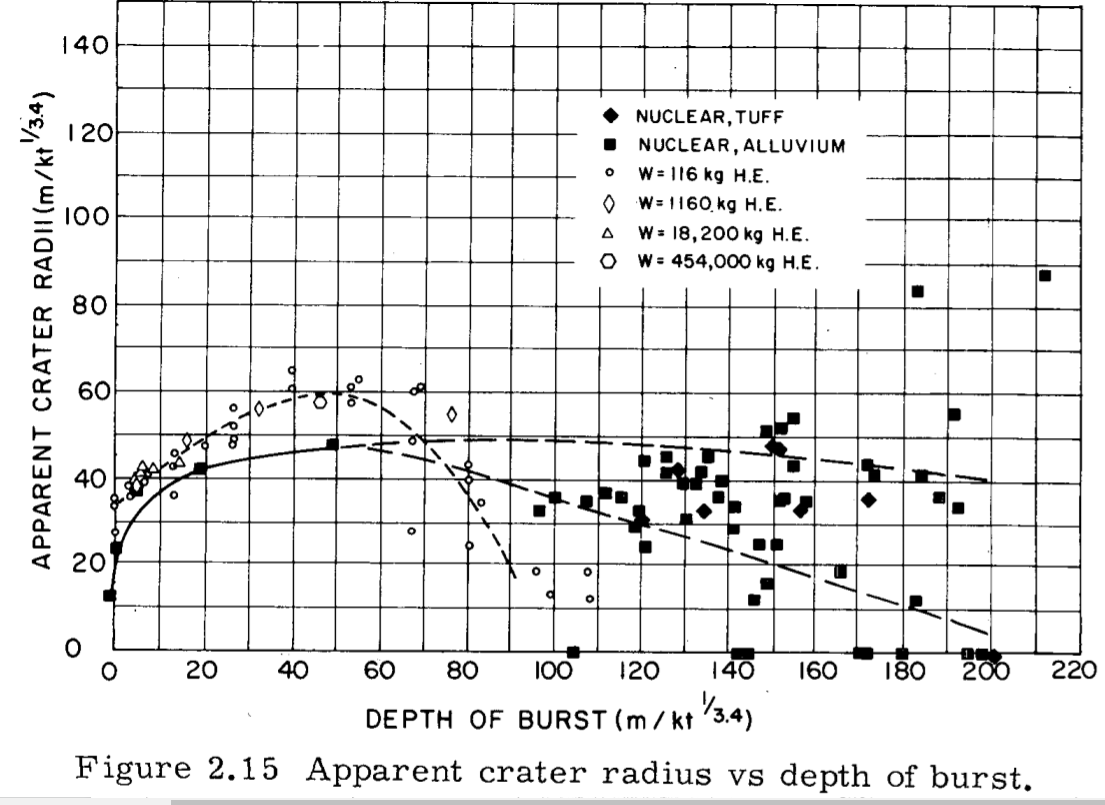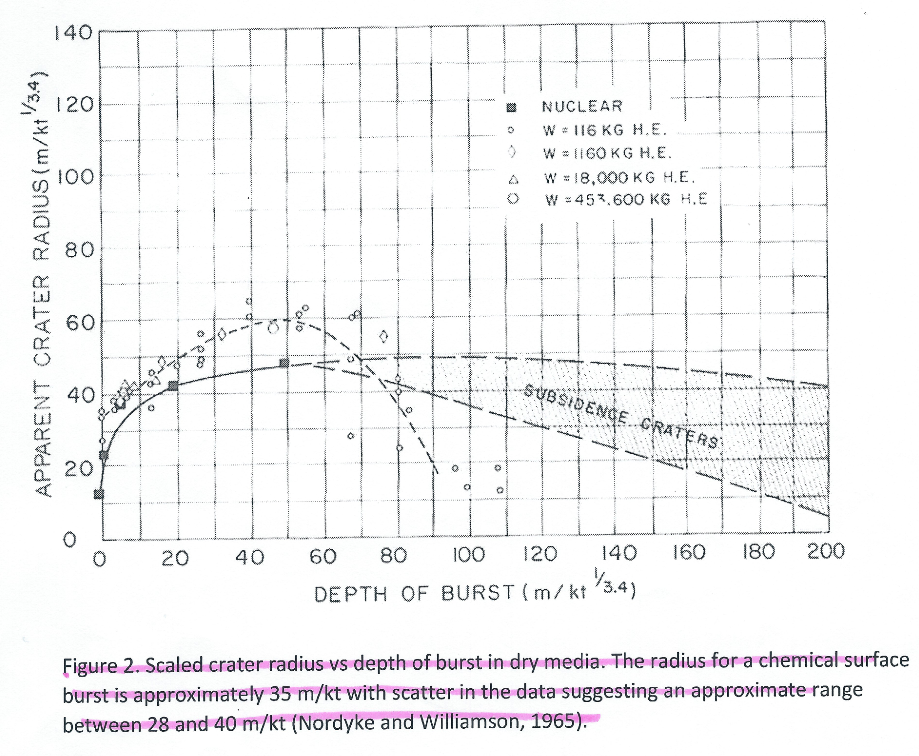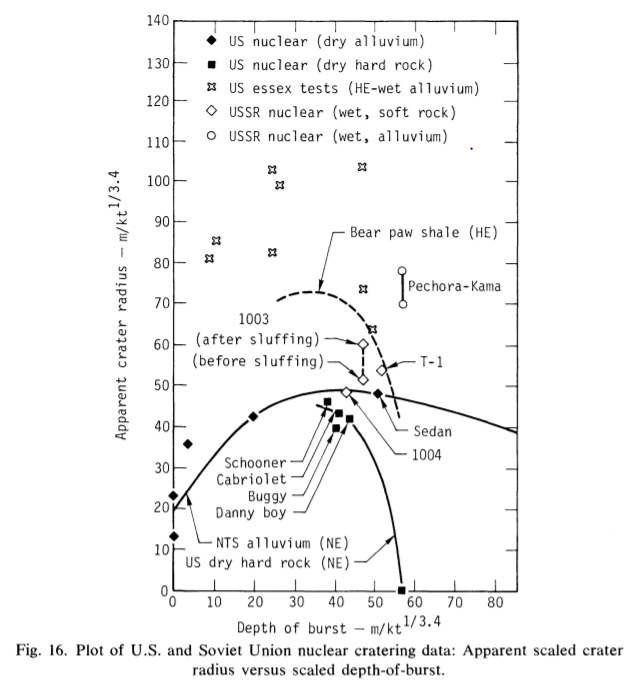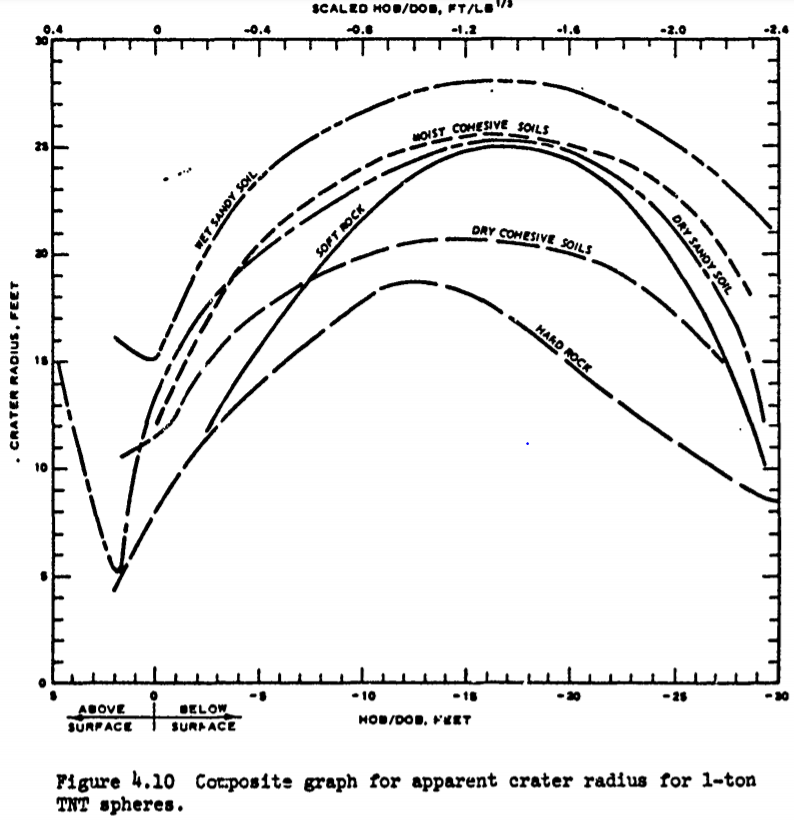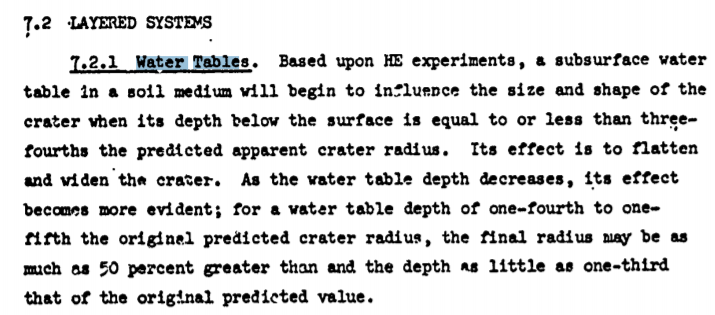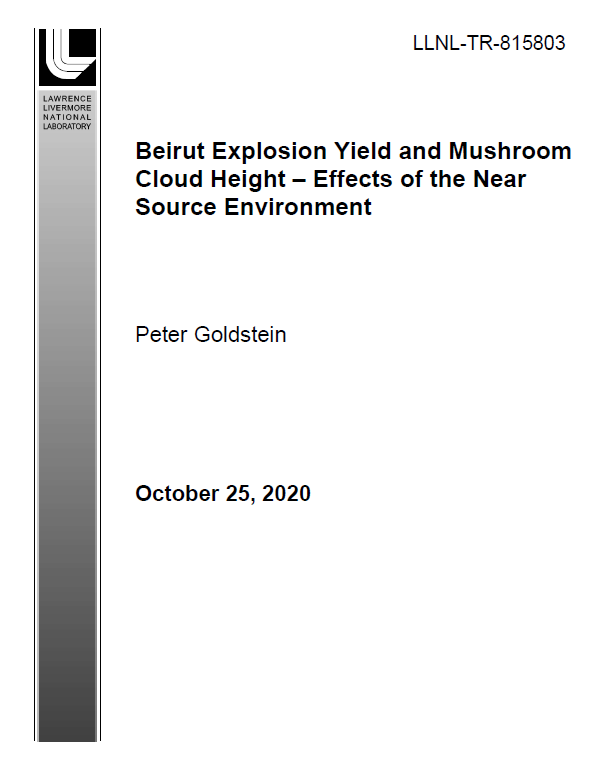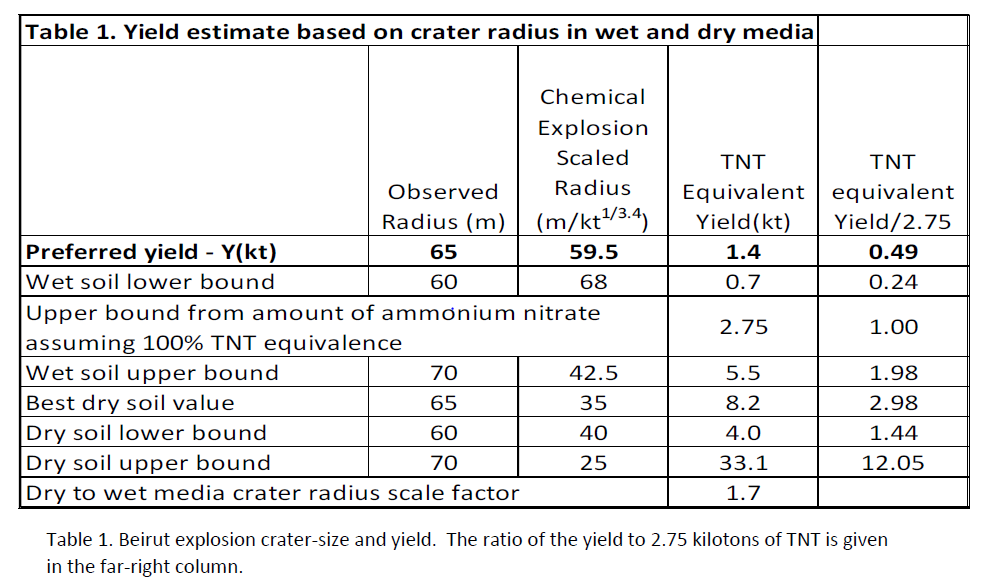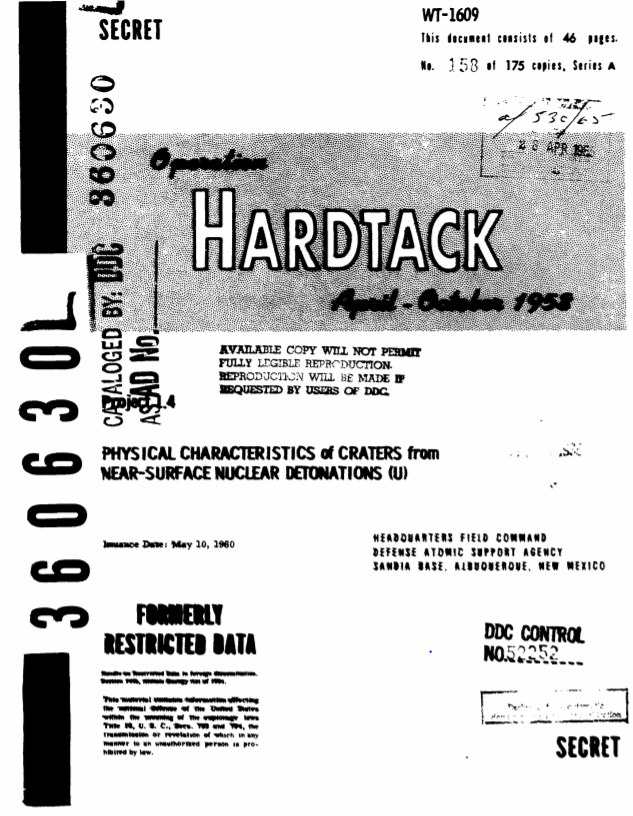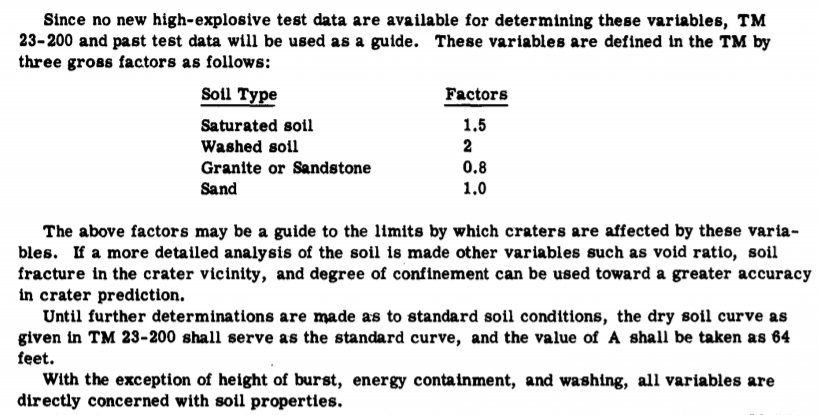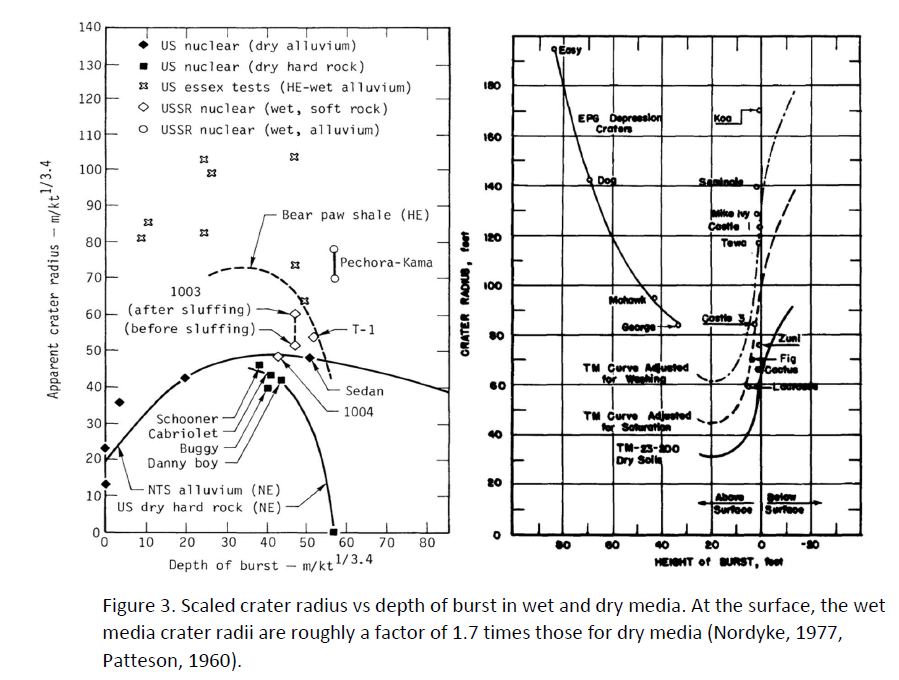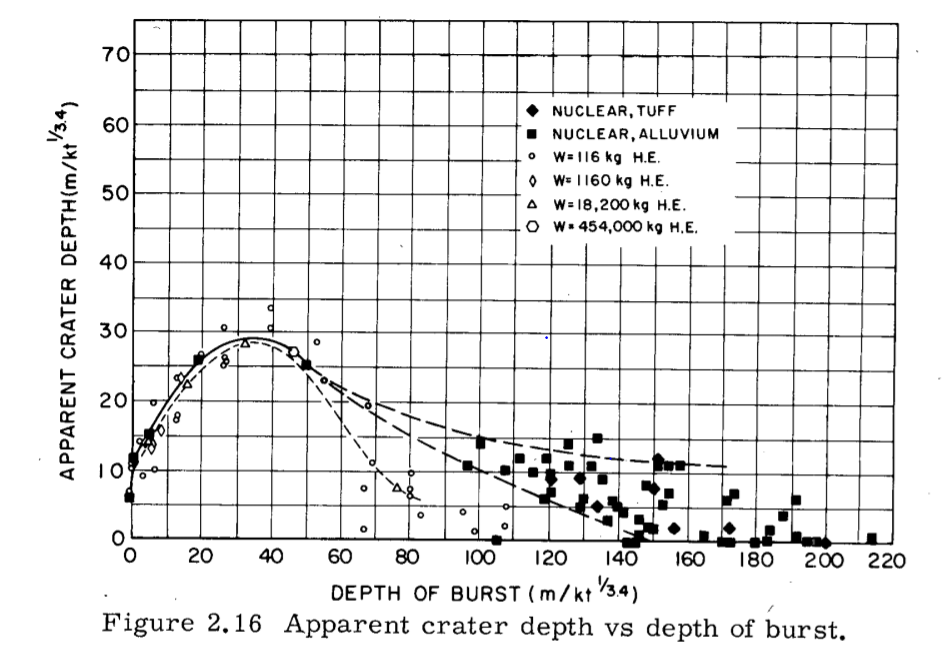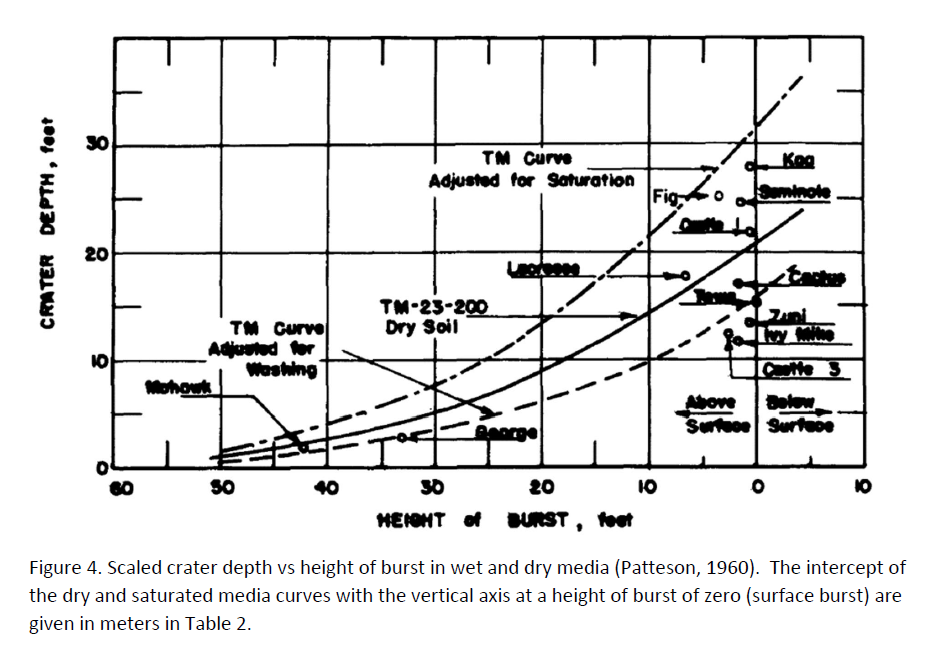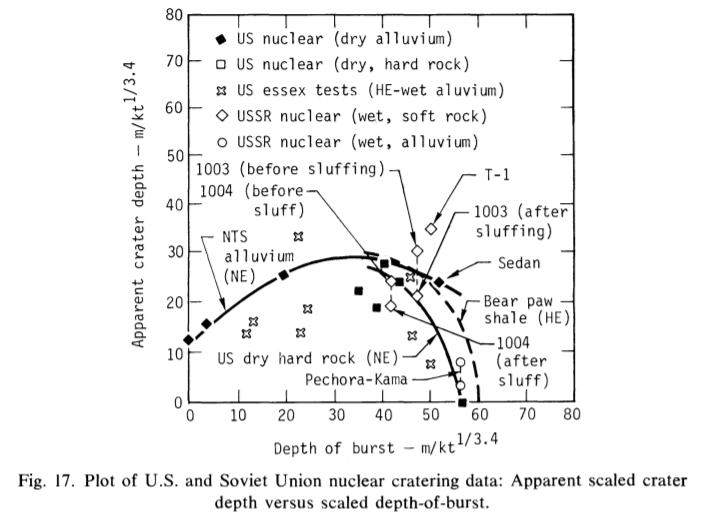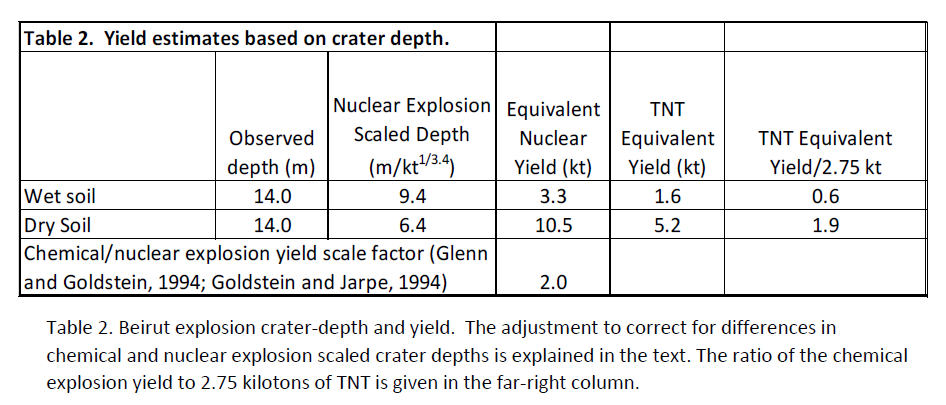Peter Goldstein’s first attempt to use cratering analysis was “Beirut Explosion Yield and Debris Could Height – The Effect of Media Saturation and Harbor Proximity,” published online as an LLNL document of 17 August 2020.
Goldstein begins his calculation of the explosive yield of the Beirut blast by turning to Nordyke and Williamson’s The Sedan Event (1965), using a modified version of their Figure 2.15 for his Figure 2.
Note: Unfortunately I did not download the pdf of the August 2020 Goldstein paper before it was deleted from the web so images from this paper (like Figure 2) come from scans of a copy I printed and are thus not as clear as they might be from a pdf.
Goldstein attempted to use his Figure 2 to calculate the explosive yield based on a known crater radius and the assumption that the explosion was a surface burst. Erroneously, he assumed the 2020 Beirut explosion was literally a surface explosion (i.e., HOB = 0). We have already discussed why that is a mistaken assumption in the case of Lance’s Wired article (discussed at length in Chapter 2) but one might easily forgive Lance because she was just following the dubious Equation 1-4. But anyone familiar enough with scaled cratering diagrams like Figure 2.15 to use them to calculate explosive yields should have known HOB = 0 was an erroneous assumption.
Using his Figure 2, Goldstein finds that the scaled radius at HOB = 0 is 35 m/kt^(1/3.4) because the N&W’s HE linear regression curve intersects the y-axis at 35. (Throughout the article, Goldstein strangely writes the scaled units as “m/kt” rather than the correct “m/kt^(1/3.4)”.)
Goldstein then suggests rather dubiously “the range would likely be between about 28 m/kt and 40 m/kt”. How does he determine this range? Well, he seems to get 28 from a single outlier 116 kg HE test @ HOB=0 although there is no outlier at 40 @ HOB=0. Surely some other measure of spread like standard deviation would be a more accurate way of reflecting the fact that all the other data points seem to be clustered around the mean?
Unfortunately, as tweeters were quick to notice, in making his calculations, Goldstein mistakes diameter for radius! “I use typically reported value (120 to 140 m) for the crater radius range and use the midpoint of these values [i.e., 130 m] as the preferred estimate.”
But, fortunately or unfortunately, as Table 1 clearly shows, Goldstein then offset the effect of the wrong radius by using the wrong exponent (1.34 rather than 3.4) to calculate explosive yield!
Undoubtedly, Goldstein first did these miscalculations using the range of scaled apparent crater radii he got from his Figure 2, i.e., a low of 28, a high of 40 and preferred 35, but immediately found the resultant explosive yields coming up too high to be explained by 2.75 kt of ammonium nitrate.
We get a sense of the numbers he came up with in Table 1 in the line “Dry lower bound” which uses the smallest observed “radius” of 120 m and the largest scaled radius (for some reason he opts for 45 here rather than the 40 he had earlier decided on!) to calculate (however erroneously) an explosive yield of 3.7 kt.
Goldstein must have also used his largest observed “radius” of 140 m and the smallest scaled radius of 28, to come up with an even higher yield of 8.6 kt for his “Dry upper bound” as well as a “preferred” dry yield (130 m radius and 35 scaled radius) of 5.8 kt.
Throughout the August 2020 paper, Goldstein seems to mistakenly assume that 2.75 kt of ammonium nitrate could theoretically have an explosive yield of 2.75 kt of TNT! He also recognized that “the likelihood that the efficiency of the explosion was less than optimal” so the explosive yield was quite likely to be less than 2.75 kt of TNT. But one thing he knew for sure is that the yield could not be GREATER than 2.75 kt! Thus the numbers he was getting like 8.6 kt, 5.8 kt, even 3.7 kt for “dry media” were way too high to be acceptable.
Media Saturation
In his August 2020 paper, Goldstein considered various plausible explanations for why the yields were too high: (1) significantly more explosives stored at the harbor; (2) “the configuration and confinement of the explosion by its surroundings”; (3) “a sharp transition from soft alluvial layers to a hard rock layer a short distance beneath the explosion”; and (4) “media saturation” (e.g., wet rather than dry alluvium) due to “the proximity of the harbor to the explosion.”
In the end, Goldstein decided that “media saturation” was the most likely explanation, although he admits “we are not certain that the medium below the explosion was highly saturated.” The numbers he was getting for scaled radii from his Figure 2 were simply too low because they were based on tests that were all in “dry media” (i.e., low moisture content) whereas Quay 9 where the Beirut warehouse was located in the port of Beirut was quite likely “wet media.”
As for how to get numbers for scaled crater radii for “wet media,” Goldstein realized information on wet media was certainly not as readily available as for dry media. Fortunately, Goldstein found that Milo D. Nordyke in his paper “Nuclear cratering experiments: United States and Soviet Union” (1977) summarized the results of five nuclear cratering tests (1003, 1004, T-1, T-2, and Pechora-Kama) performed in the former Soviet Union which were all “in relatively high moisture situations which were generally in a saturated condition.”
Nordyke explains that in the presence of moisture in the media, a nuclear explosion produces “non-condensable” gas. Gas acceleration assists with the cratering action along with the “the palling of surface layers of rock in reaction to the shock wave”. Thus, all other things held constant, explosions in a moist media can produce both a wider and deeper crater than in dry media.
Samuel Glasstone and Philip J. Dolan’s The Effects of Nuclear Weapons, 3rd ed. (1977) go into more detail on the role of moisture in the media in their explanation of the mechanics of crater formation of a “shallow underground explosion” (2.90-2.94).
2.91 When a nuclear weapon is exploded under the ground, a sphere of extremely hot, high-pressure gases, including vaporized weapon residues and rock, is formed. This is the equivalent of the fireball in an air or surface burst. The rapid expansion of the gas bubble initiates a ground shock wave which travels in all directions away from the burst point. When the upwardly directed shock (compression) wave reaches the earth’s surface, it is reflected back as a rarefaction (or tension) wave. If the tension exceeds the tensile strength of the surface material, the upper layers of the ground will spall, i.e., split off into more-or-less horizontal layers. Then, as a result of the momentum imparted by the incident shock wave, these layers move upward at a speed which may be about 150 (or more) feet per second.
2.92 When it is reflected back from the surface, the rarefaction wave travels into the ground toward the expanding gas sphere (or cavity) produced by the explosion. If the detonation is not at too great a depth, this wave may reach the top of the cavity while it is still growing. The resistance of the ground to the upward growth of the cavity is thus decreased and the cavity expands rapidly in the upward direction. The expanding gases and vapors can thus supply additional energy to the spalled layers, so that their upward motion is sustained for a time or even increased. This effect is referred to as “gas acceleration.”
2.93 The ground surface moving upward first assumes the shape of a dome. As the dome continues to increase in height, cracks form through which the cavity gases vent to the atmosphere. The mound then disintegrates completely and the rock fragments are thrown upward and outward (Fig. 2.93). Subsequently, much of the ejected material collapses and falls back, partly into the newly formed crater and partly onto the surrounding “lip.” The material that falls back immediately into the crater is called the “fallback,” whereas that descending on the lip is called the “ejecta.” The size of the remaining (or “apparent”) crater depends on the energy yield of the detonation and on the nature of the excavated medium. In general, for equivalent conditions, the volume of the crater is roughly proportional to the yield of the explosion.
2.94 The relative extents to which spalling and gas acceleration contribute to the formation of a throwout crater depend to large extent on the moisture content of the rock medium. In rock containing a moderately large proportion of water, the cavity pressure. is greatly increased by the presence of water vapor. Gas acceleration then plays an important role in crater formation. In dry rock, however, the contribution of gas acceleration to the upward motion of the ground is generally small and may be unobservable.
Based on examining Nordyke’s Figure 16 “Plot of U.S. and Soviet Union nuclear cratering data: Apparent scaled crater radius versus scaled depth-of-burst”, Goldstein concluded:
It seems clear from this data and many of the observations by Nordyke that an explosion in saturated media is likely to produce much larger crater. To first order, scaled radii in wet and dry alluvium differ by about a factor of two [emphasis added], so I use a scaled radii and range for chemical explosion surface bursts in wet media that are twice the values indicated above for dry media: 70 m/kt and 56 to 80 m/kt.
But Nordyke makes NO such assertion that “scaled radii in wet and dry alluvium differ by about a factor of two.” Indeed, in contrast to Goldstein, Nordyke actually plays down the significance of “wet” versus “dry” media in terms of its overall impact on crater depth and radius.
Indeed Nordyke noted that Storax Sedan which lies on the best-fit line was hardly “dry media.”
The moisture content in the Sedan area was between 15 and 20% and led to a significant amount of “non-condensable” gas being produced by the nuclear explosion and assisting with the cratering action. Analysis of surface motion data on Sedan showed that gas acceleration played a major role in the formation of this crater.
When Nordyke compared U.S. and Soviet data by plotting scaled apparent crater radii and depth against scaled depth of burst in Figures 16 and 17, he found that the “1004” crater compared “very favorably with the Sedan crater for both apparent radius and apparent depth reflecting the fact that the moisture content was comparable with Sedan and indicating that the medium may have been similar to alluvium in physical characteristics.”
Nordyke notes that the scaled apparent radius of the “1003” explosion is significantly larger than that of Sedan but in Figure 16, “1003” (“before sluffing”) is just barely above the “NTS alluvium (NE)” best-fit line. Indeed, although “1003” was a 1.1 kt device detonated at a depth of 48 m in a siltstone environment with an artesian water table existing at a depth of 14-20 m, the resulting scaled apparent crater radius was about what would have been expected for dry alluvium. The only difference was the action of artesian water flowing into the crater over a two-year period causing the slopes of the crater to “sluff,” resulting in an increase in apparent radius and decrease in apparent depth over two years.
Nordyke messed up a bit in plotting “T-1” and “T-2”. Firstly, he does not have any plot points labeled “T-2” at all. But, moreover, in Figure 16, the point labeled “T-1” is actually “T-2” (y = 52) while the real “T-1” should be plotted a bit higher (y = 64) with the same x-value. (In Figure 17 (see below), “T-1” is correctly plotted while the missing “T-2” should be plotted at y =26, right on the best-fit line next to “Sedan.”)
With the correctly plotted “T-1” point on Figure 16, Nordyke’s argument that the T-1 explosion was “significantly larger than the scaled apparent radius of the Sedan explosion” is strengthened even more. As to why T-1’s apparent crater radius was larger than expected, Nordyke does not say but notes that “the Soviets have attributed this to the presence of a large amount of gas-forming organic material”. He does not refute this but adds that the water table was 2 m deep (DOB = 31.4 m) so the crater filled with water within several days.
“T-2” was actually a row of three 0.2-kt nuclear explosives spaced about 40 meters apart in similar geology and DOB as T-1 except the water table was at a depth of 5.6-6.9 m. The resulting scaled apparent crater at 52 was closer to the best-fit dry alluvium line (47) than T-1 (64) was.
Pechora-Kama is clearly an outlier compared to the other U.S. and Soviet nuclear tests with a scaled apparent crater radius at 68 (before sluffing) far above the best-fit dry alluvium line as can be seen in Figure 16 and a scaled apparent crater depth at 6.8 (before sluffing) in Figure 17 (see below) far below the line.
Three 15-kt explosives were placed at depths of about 128 m, with two of the explosions within underlying rock formation while third 5-10 m above the alluvium-rock interface with the water table such that it left “a majority of the loose, cohensionless, alluvial sediments being saturated.”
Nordyke has no explanation for why Pechora-Kama is such an outlier but offers a comparison with the Essex HE in saturated, unconsolidated sand and the Bearpaw shale cratering experiments which both were characterized by radii much larger and depths much smaller than those found in NTS alluvium (especially the Essex HE tests).
Nordyke concludes based on the Soviet cratering studies that explosions in “saturated or partially saturated media…has led to larger craters being formed initially, followed by varying degrees of slope failure resulting from the saturated conditions and readjustment of crater slopes.”
So how could Goldstein possibly have concluded that “To first order, scaled radii in wet and dry alluvium differ by about a factor of two”?
The only seemingly possible way that Goldstein could have come up with “a factor of 2” is by comparing a seemingly random scattering of data points (through which Nordyke did not even attempt to fit a line) from a complete outlier—the Essex HE cratering tests— with the NTS dry alluvium (NE) best-fit line that is the standard by which all cratering tests are measured. Goldstein completely ignores the results of Nordyke’s comparison of the “1003,” “1004,” T-1 and T-2 tests that shows media saturation hardly has any effect on calculations of crater dimensions, apart from the impact of sluffing.
Furthermore, what Goldstein was after was after was the scaled apparent crater radius @ HOB = 0 which Figure 16 does not depict for the Essex HE tests and it is anybody’s guess what a best fit through the Essex points would cross the y-axis. Goldstein could have claimed wet and dry alluvium differed by a factor of 3, or 4, or whatever.
If Goldstein was seriously interested in studying the effect of media saturation, there are several studies out there that do just that. Cratering by Explosions: A Compendium and an Analysis (1974) summarizes most of the available evidence as of the date of publication.
For example, Figure 4.10 shows that, although moist/wet media almost always produce larger craters than the equivalent dry media for the same explosive yield, the difference is hardly a factor of two. At the peak of the curves “wet sandy soil” (at 28) differs from “dry sandy soil” (at 25) by a factor of 1.1. “Moist cohesive soils” differs from “dry cohesive soils” by a factor of 1.25. Furthermore, these wet and dry medias tend to converge as HOB approaches zero, so the factor that Goldstein is interested in may actually be just 1.0.
Furthermore, it is interesting that Cratering by Explosions: A Compendium and an Analysis (1974) reports a similar kind of phenomena to that of the Essex HE tests where the craters are both wider and flatter than expected as due, not to media saturation, but a “water table effect.”
Surely, with regard to his assumption about a surface blast in a warehouse at the port of Beirut, this kind of “water table effect” would be more relevant than assuming complete saturation of the media.
However unjustified the factor of 2.0 is, Goldstein was able to use it to significantly reduce the explosive yields he was calculating (based on wrong radius, exponent, and scaled radius!), with a “wet lower bound” of 1.7 kt TNT equivalent, “wet upper bound” of 3.4 kt, and “preferred [wet] value” of 2.3 kt.
October 2020 Report
In October 2020, Goldstein published a completely revised version of his August 2020 paper, titled “Beirut Explosion Yield and Mushroom Cloud Height – Effects of the Near Source Environment.”
In preparing Table 1 in his October 2020 paper, Goldstein cleaned up all of his obvious errors (e.g., radius, exponent) but once again seems determined to prove the “official” story, this time suitably alert to having to come up with an explosive yield much smaller than what he came up with back in August.
Although Table 1 includes explosive yields for both “wet soil” and “dry soil,” once again Goldstein based his “preferred yield” on wet rather than dry soil repeating the logic from the August 2020 paper “because it seems likely that the media below the explosion was highly saturated due to its proximity to the harbor.” He doesn’t provide any additional evidence beyond “it seems likely” but he does add a bit of scientific jargon:
I present evidence that suggests that the relatively large crater radius is due to a high degree of coupling of shock wave energy to the surrounding medium and a reduction of the effective stress because of a high level of saturation of the geologic media beneath the explosion.
Goldstein would have been even more motivated to focus on “best wet soil value” because when he finally (correctly) calculated the “best dry soil value” (see Table 1 below) he got an explosive yield of 8.2 kt with a lower bound 4.0 kt and upper bound a wopping 33.1 kt!
Perhaps realizing that he had very dubious grounds for claiming a “factor of two” based on Nordyke in the August 2020 paper, Goldstein for the October paper turns to an older source, A. W. Patteson’s Operation Hardtack (April-October 1958): Physical Characteristics of Craters from Near-Surface Nuclear Detonations (1960).
https://apps.dtic.mil/dtic/tr/fulltext/u2/360630.pdf
Patteson comes right out and asserts that based on “TM 23-200 and past test data” he has determined that the dry-to-wet-media (scaled) crater radius scale factor is 1.5.
Nevertheless, unwilling to just go with Patteson, Goldstein proceeds to interpret Patteson’s Figure 1 (the right side of Goldstein’s Figure 3) to somehow determine that 1.5 was only “the lower bound” with 2.0 “the upper bound” and 1.7 “preferred.” Goldstein ignores Patteson’s comment on Shot Cactus that “It is probable, however, that a factor of 1.4 instead of 1.5 should have been used as the saturation factor since the top few feet of the soil around ground zero was above the water table and was essentially in a dry state” (p. 22). This would seem like Patteson was recognizing some kind of “water table effect” but Patteson’s effect reduces both crater radius and depth whereas the “water table effect” noted above said the crater was wider and shallower than expected.
As in the August 2020 paper, Goldstein multiplies the scaled radii he determined from his Figure 2 by his conversion dry-to-wet conversion factor, this time using 1.7 rather than 2.0. He thus lowers the upper/preferred/lower bounds for the scale radii for wet soil @ HOB = 0 from 56/70/80 down to 42.5/59.5/68. Goldstein then calculates for wet soil a lower bound for the explosive yield of 0.7 kt, a preferred yield of 1.4 kt and an upper bound of 5.5 kt. However, since he has arbitrarily established that the upper bound cannot exceed 2.75 kt TNT equivalent (as if the relative efficiency of ammonium nitrate was 1.00), in his abstract he just assumes an upper bound of 2.75 kt rather than the calculated 5.5 kt.
Apparent Crater Depth
The logic of Goldstein’s approach to cratering analysis as a means to manipulate data in order to support the “official” story comes out most clearly in his treatment of apparent crater depth which he deals with for the first time in his October 2020 paper.
Check out the way he justifies using the 15-yard crater depth reported by the Washington Post over the more widely reported 43-meter depth because the calculated yield would be too large:
There is limited and conflicting information on the depth of the Beirut explosion crater. Dadouch (2020) reports a crater depth of about 15 yds (14 m) and multiple sources report a depth of 43 m (Wikipedia, 2020). Dadouch’s (2020) value is probably the more accurate one since the larger depth, 43 m, would imply a very large yield (approximately 47 kilotons) based on the prior crater-depth scaling data. The larger value probably should have been reported as feet rather than meters. If so, both values would be very similar.
For identifying scaled apparent crater depth in dry media, Goldstein for some reason turns from the trusted Nordyke & Williamson (1965) to Patteson (1960), claiming
Unfortunately, scaled crater-depth data from large chemical explosion is also limited and, as indicated by Nordyke (1977), highly variable. Data from nuclear explosions in Patteson (1960) appear to be more reliable (Figure 4).
This argument makes absolutely no sense. Goldstein found the HE curve in Nordyke & Williamson’s Figure 2.15 perfectly satisfactory for calculating scaled apparent crater radii in both the August and October 2020 papers and never found the data limited and highly variable.
On the other hand, Patteson (1960) has practically NO data and Goldstein anyway really only uses the y-intercepts of Patteson’s “TM-23-200 Dry Soil” and “TM Curve Adjusted for Saturation” curves for his calculations.
One effect that using Patteson’s Figure 4 and its NE curve has on the calculations is that Figure 4’s scaled crater depth @ HOB = 0 is 21 ft/kt^(1/3) (Patteson uses cube root scaling) while if Goldstein had used the HE curve on N&W’s Figure 16, the scaled crater depth @ HOB = would be 10 m/kt^(1/3.4), or 32.8 ft/kt^(1/3.4). But actually the NE curve on Figure 16—or Figure 4.3 for that matter—would have given him the same result as Figure 4 because they are all based on the same NTS data. Using the higher number would have actually helped Goldstein keep his calculated explosive yield down which seems one of his big concerns!
I suspect one possible reason that Goldstein abandoned the approach that he used for crater radius when he approached crater depth was because those same Essex HE tests he seemingly had used to come up with 2.0 for a dry-to-wet-media (scaled) crater radius scale factor, while they had much greater than expected crater radii actually had much lower than expected crater depths so Goldstein was going to come up with even greater explosive yields for wet media than dry media! (Goldstein does not include Nordyke’s Figure 17 in his October 2020 paper.)
Once again it is anyone guess how you would draw a curve through the Essex test data points. The ratio of the Essex data points to the NTS alluvium line is about 0.40 around a scaled depth of burst of 50 m/kt^(1/3.4) going up to 0.58 @ 25, and 0.75 @ 10. The Essex data points look like they are converging on the NTS alluvium line as the data points get closer to HOB = 0. At the very least we could say that if we don’t have a single dry-to-wet-media (scaled) crater depth scale factor but it is always 1.0 or less, certainly not the constant 1.5 that Goldstein adopts from Patteson. Patteson’s craters in wet media are both wider and deeper than in dry media all other things held constant where the Essex craters are wider and shallower (much like the “water table effect” mentioned above).
In calculating Table 2 “Yield estimates based on crater depth”, Goldstein follows a similar procedure to that used in his October 2020 Table 1 but with some questionable differences.
First, he has no upper or lower bound on “Observed depth”, likely because he does not want to deal with the “official” 43-m apparent crater depth.
Second, while he gets the “Nuclear Explosion Scaled Depth” of 6.4 for “dry soil” straight from Patteson, he calculates the scaled depth for “wet soil” of 9.4 by multiplying by 1.5 rather than the 1.7 he used for scaled radii. (Actually, he probably just took the “wet soil” off of the “TM Curve Adjusted for Saturation” which Patteson had obviously created with a factor of 1.5.)
Third, it is curious he gives the units as m/kt^(1/3.4) since Patteson uses cube root scaling but one suspects Goldstein was just following the (1/3.4) scaling as the cratering analysis standard since the mid-1960s. But even more curious is that for calculating “Equivalent Nuclear Yield (kt)” Goldstein assumes cube-root scaling. If Goldtein had used (1/3.4) scaling, the yield would have been higher: 3.9 kt instead of 3.3 kt for “wet soil” and 14.3 kt instead of 10.5 kt for “dry soil.”
Fourth, and most importantly, Goldstein slips in a very strange “Chemical/nuclear explosion yield scale factor” of 2.0 to cut the “Equivalent Nuclear Yield (kt)” in half and produce the (supposedly actual) “TNT Equivalent Yield (kt)” citing two joint papers he presented at a 1994 conference but otherwise does not bother to explain! What he is saying is that an HE explosive is twice as efficient as a NE explosive of the same nominal yield when it comes to blasting a crater. I guess he must have been really desperate to come up with this BS! Was this the real reason he chose to go with the NE curve from Patteson rather than N&W’s HE curve he had used for scaled crater radii?
A brief look at N&W’s Figure 2.16 show that the HE and NE curves practically overlap for scaled depths of burst in the range 0-50 m/kt^(1/3.4). Indeed, the NE curve is slightly higher than the HE curve suggesting a nuclear explosive will blast a slightly deeper crater than a high explosive of the same yield.

